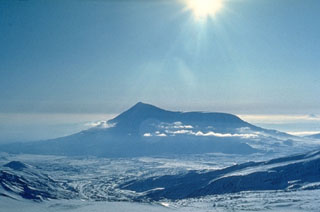Report on Tolbachik (Russia) — May 1976
Natural Science Event Bulletin, vol. 1, no. 8 (May 1976)
Managing Editor: David Squires.
Tolbachik (Russia) Eruption now almost a year old; possibly four new cones
Please cite this report as:
Global Volcanism Program, 1976. Report on Tolbachik (Russia) (Squires, D., ed.). Natural Science Event Bulletin, 1:8. Smithsonian Institution. https://doi.org/10.5479/si.GVP.NSEB197605-300240
Tolbachik
Russia
55.832°N, 160.326°E; summit elev. 3611 m
All times are local (unless otherwise noted)
Plosky Tolbachik has been in a state of eruption for almost a year. It was reported on 17 May that a new volcano was developing near there, and a group of IVP scientists is investigating the eruption. They stated that "this is one of the biggest and most interesting volcanic eruptions this century." Reportedly, a chain of new volcanoes was formed during the eruption, four of which are fairly large. "Streams of fire" have been active for nearly a year.
Geological Summary. The massive Tolbachik volcano is located at the southern end of the Kliuchevskaya volcano group. The massif is composed of two overlapping, but morphologically distinct, volcanoes. The flat-topped Plosky Tolbachik shield volcano with its nested Holocene calderas up to 3 km in diameter is located east of the older and higher sharp-topped Ostry Tolbachik stratovolcano. The summit caldera at Plosky Tolbachik was formed in association with major lava effusion about 6,500 years ago and simultaneously with a major southward-directed sector collapse of Ostry Tolbachik. Long rift zones extending NE and SSW of the volcano have erupted voluminous basaltic lava flows during the Holocene, with activity during the past two thousand years being confined to the narrow axial zone of the rifts. The 1975-76 eruption originating from the SSW-flank fissure system and the summit was the largest historical basaltic eruption in Kamchatka.
Information Contacts: Y. Doubik, IVP.

